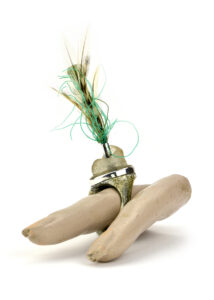To view work associated with this essay, please click the image below

If you walk east along the coast from Lyme Regis in Dorset, past the ‘Mary Anning Rocks’ sculpture to the end of the relatively recently constructed (and soon to be overwhelmed) sea defence wall you will find yourself at the top of a set of concrete steps which will in turn take you down to the west end of East Cliff Beach. This stretch of shoreline, also known as The Spittles, forms a part of the ‘Jurassic Coast’ World Heritage Site; an area stretching from Exmouth in East Devon to Studland Bay in Dorset. Consequently, the beach sees more than its fair share of amateur fossil-hunters who can always be recognised by the incessant, dull tinging of their rock- and peace-shattering hammers, their lack of eye protection and their propensity to stand under shale cliffs which precariously and temporarily support placards warning of the high danger of further landslips.
I first visited Lyme (near to which I am lucky enough to now live) in 1999. I was staying on a campsite in Uplyme, which is located roughly where you might expect it to be and is about twenty minute’s walk to the town itself. Having had a camera of one format or another in my hand for nearly as long as I can remember, and because I was on holiday, my eyes immediately switched onto its uniqueness as a place; yes, it is a fairly classically pretty seaside town and yes, it has some higgledy-piggledy houses with pastel-painted front doors and yes, the light is different there and yes, when the sea is still it menacing and the water lurks with an eerie, oily slickness and yes, it has a pasty shop and a fudge shop and all the usual seaside trappings. But it has something else as well; it has contradictions, and it has incongruities.
One of the things that struck me about the place was its diversity. You want a sandy beach with huts,a promenade, ice-creams and cheap hats? You’ve got it. One with pebbles? Right next door. Sharp, jagged slabs of limestone angling into the channel more your thing? Try Broad Ledge. Boulder, sand and dog-friendly? Head for Monmouth Beach. Or for East Cliff, where you can spend a happy hour or so running the lurcher and watching natural selection at work in real time. It’s my favourite part of the whole Lyme Regis experience; not because I can run my dogs or to guffaw at the stupidity of others, but because I too am hunting for remnants of the past.
In 1978, the gates of the municipal dump just off the Charmouth Road closed for the last time after over a hundred years of being open, leaving the mounds of redundant domestic and industrial machinery, building surplus, vehicles and assorted small, land-locked jetsam to slide into obscurity and to vanish forever. Well, slide they did, but vanish? No, well, certainly not forever. Those same cliffs that continuously threaten to slightly deepen the gene-pool, as they slip and crumble – sometimes slowly, sometimes dramatically quickly – beachwards have, over the last few decades, begun spewing out the trash that has been sucked through the sediments over the last century and a half, appearing silt-smoothed and elementally patinated on The Spittles. ‘Champion’ spark plugs, their ceramic, red-logoed bodies largely unchanged whilst their steel has been rusted to a brace of rounded nubs; crazy zigzags of oxidised rebar, jagging awkwardly skyward and startling orange against the slate shale; cast iron engine blocks, eaten though to their cylinders revealing long-seized pistons, con-rods, big and little ends; keys, cutlery, handles, fire-irons, coins – some silver, mostly base; small, anonymous but often strangely anthropomorphic, jewel-sized jumbles of non-ferrous metals, occasionally fused or otherwise set with other durables.
After over two decades of hauling tens of kilos of the former back home to rust further, it is these latter curios that I now seek out. These are the things that speak to me as our paths coincide fleetingly; those that catch an eye that occupies the same skin that shrouds middle-aged muscles and feeds information to a slightly wiser mind. How, I ask each object vying for salvation, will you look when I get you home? I’ve picked up and carried too many water-varnished, salt-licked pebbles to be fooled as easily I was once was. The lucky ones – sometimes the ones that tell me of their potential for preciousness, sometimes those that simply make me smile – are the ones that make my pocket.
I bring them home, wash them of their decaying salts, brush off their abrading sand and dry them before placing them on my bench, waiting patiently for them to sing to me of their past travels and where they are headed next. I do not sing back (that would be absurd, no?), but on occasion – if they remain mute – I can be heard talking to them, cajoling them in to telling me what they want to be. They usually answer slowly in cryptic whispers that nobody else can hear.
Robin Shelton
Devon, December 2023